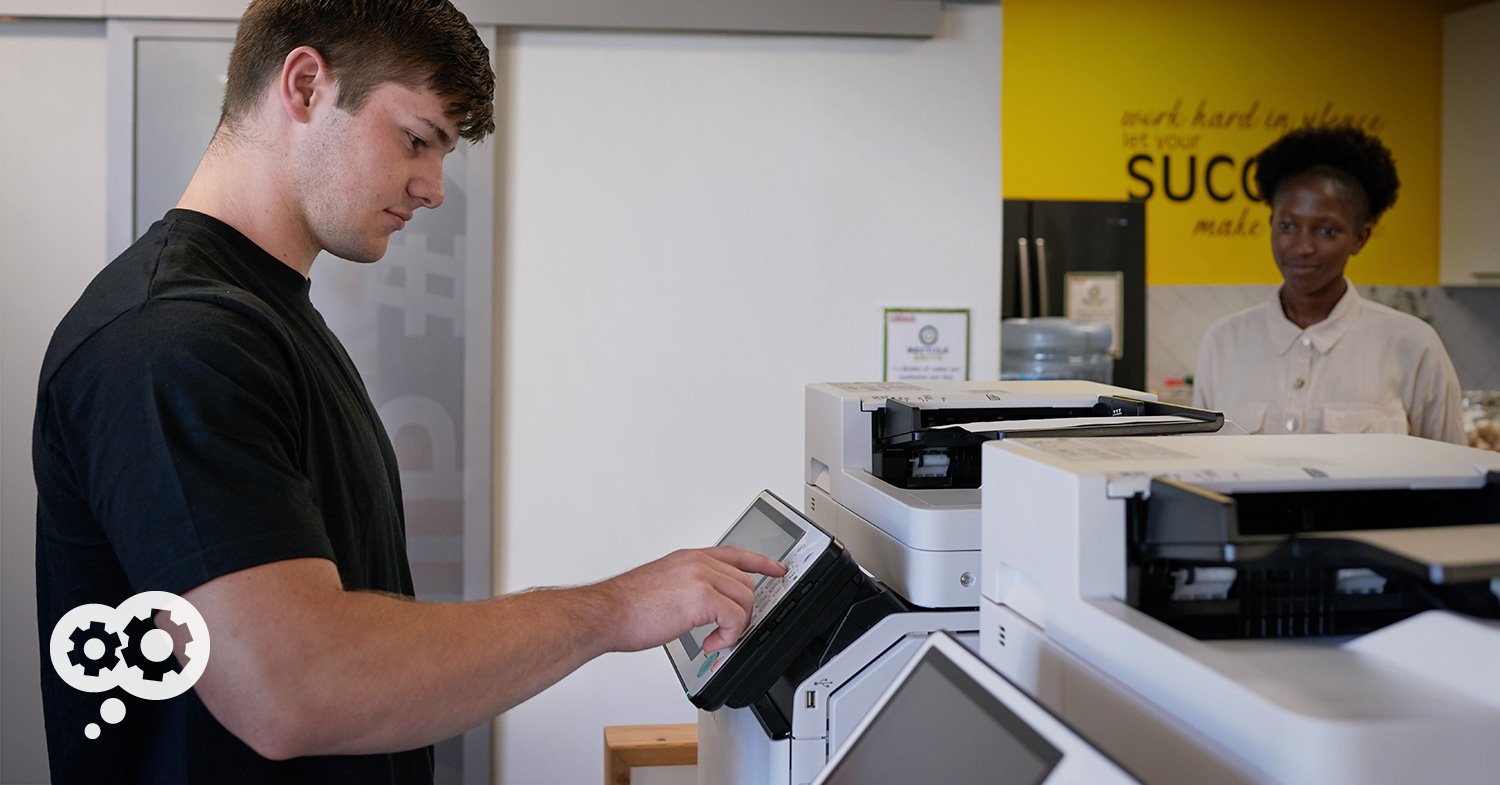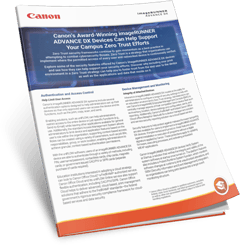
The following provides a closer look at the security capabilities of Canon's imageRUNNER ADVANCE DX devices and how incorporating your print environment into a Zero Trust strategy can foster trust between the end user students/faculty, the device, and the associated data.
If and when someone approaches a multi-function printer on your campus, have you considered an ideology of "Never trust, always verify"?
The adoption of zero-trust security frameworks is increasing as a recommended approach to addressing cybersecurity risks, and with good reason. The Pandemic brought many changes, but among them, the sudden shift to remote work (and virtual learning environments) in 2020 brought to light the need for more comprehensive security.
Since that time, the need for enhanced security on campus has only strengthened. As schools plan accordingly for Zero Trust environments, print devices should not be left out of the conversation. Quocirca’s Global Print Security Landscape 2022 report found that more than two-thirds (68%) of organizations experienced data loss due to unsecured printing practices in the past 12 months.
What is a Zero Trust Environment?
The main concept behind the Zero Trust security model is "never trust, always verify," which means that users and devices should not be trusted by default, even if they are connected to a "permissioned" network such as a corporate LAN, and even if they were previously verified. While it is more of a concept than a set of written rules, Zero Trust involves regularly verifying the authorized access of all users and networked devices within an organization.
The following provides a closer look at the security capabilities of Canon's imageRUNNER ADVANCE DX devices and how incorporating your print environment into a Zero Trust strategy can foster trust between the end user students/faculty, the device, and the associated data.
4 Areas Canon + uniFLOW Can Bolster Print Security on Campus.
1. Limiting User Access.
Canon’s imageRUNNER ADVANCE DX systems offer various authentication options to give system administrators control over device access and functions. These options ensure that only authorized users can utilize features like printing, copying, scanning, and sending.
By utilizing solutions like uniFLOW, administrators can further restrict access to the entire device or specific functions (e.g., Send-to-Email), while still allowing general use of other applications. The Access Management System, which comes as standard, enables administrators to limit device and application features based on a user's role within the organization. This context-based access can be defined by parameters such as job title, responsibilities, group, or work location, offering detailed and precise authentication permissions.
Users of the imageRUNNER ADVANCE DX device, with the integration of uniFLOW software, can authenticate themselves using different methods, including PIN, username/password, contactless cards, chip cards, magnetic cards, or government-issued CAC/PIV or SIPR cards (separate purchase of cards required).
For educational institutions considering a cloud strategy, Canon Office Cloud is a FedRAMP-authorized service that can be explored. Both Canon Office Cloud and its uniFLOW Online service support flexible authentication, including CAC/PIV/SIPR. Canon Office Cloud delivers advanced, cloud-based print management solutions that adhere to the FedRAMP standards, ensuring stringent security compliance for cloud-based services and data security.
2. Insuring Integrity of Attached Devices.
 The imageRUNNER ADVANCE DX models have built-in features that allow administrators to configure security settings to support the Zero Trust strategy in an educational environment. The imageWARE Enterprise Management Console (EMC) from Canon can be used to centrally manage various aspects of Canon devices, including inventory, location, settings, alerts, and reporting. Canon's FedRAMP-authorized Canon Office Cloud offers Netaphor SiteAudit as a cloud-based service for device management and security reporting.
The imageRUNNER ADVANCE DX models have built-in features that allow administrators to configure security settings to support the Zero Trust strategy in an educational environment. The imageWARE Enterprise Management Console (EMC) from Canon can be used to centrally manage various aspects of Canon devices, including inventory, location, settings, alerts, and reporting. Canon's FedRAMP-authorized Canon Office Cloud offers Netaphor SiteAudit as a cloud-based service for device management and security reporting.
Users of imageRUNNER ADVANCE DX devices can also utilize security features to protect against malware and firmware tampering. These features prevent the installation or execution of programs without a digital signature from Canon. They apply to firmware updates, process execution, and MEAP applications.
The Verify System at Startup feature in Canon imageRUNNER ADVANCE DX devices ensures the integrity and validity of the system software during startup. The platform also includes the Protect Runtime System function, which monitors software changes to prevent unauthorized alterations, and supports SIEM integration for print devices to be included in a larger event monitoring structure.
3. Safeguarding Network Communications.
Canon’s imageRUNNER ADVANCE DX devices offer several security features to assist educational institutions in safeguarding their important data and information. These devices allow network administrators to customize the device protocols and service ports that can be accessed.
The firewall settings can be adjusted to restrict unauthorized access and protect against network attacks and intrusions by allowing communication only with specific IP addresses. Additionally, administrators can receive alerts if there are any changes to the networking configurations using tools like Netaphor SiteAudit.
4. Shielding Data and Information.
In order to shield your sensitive and confidential data, Canon imageRUNNER ADVANCE DX systems come equipped with a standard SSD format utility and advanced features like SSD Data Encryption (FIPS 140-2, 256 AES). Each device also offers a Trusted Platform Module (TPM) and an SSD lock feature that requires a password, ensuring that accessing the stored data becomes challenging.
Additionally, Canon has incorporated various controls to minimize the risk of data compromise. These controls include Secure Print, restrictions on scan destinations, digital signatures for documents, and PDF encryption, among others.
Furthermore, the Canon Office Cloud solution provides additional security measures such as secure print and destination restrictions for Scan to Self, network folders, FedRAMP-authorized version of Box, Google Drive, Microsoft OneDrive, Exchange, and Teams.
How do I develop a Zero Trust Print Management approach on our campus?
First off, as you develop your Zero Trust approach to data, documents, and networked environments, take an inventory of all of your print devices, embedded device software, and services. Secondly, evaluate Canon and their extensive experience in providing advanced print security solutions can assist you in incorporating print and document management into your Zero Trust strategy. Lastly, and most importantly, pick a partner that's dedicated to technology security.
Datamax can help. As a Canon Advanced Partner for 10 straight years, we can help your school better understand and properly implement a Zero Trust environment for your print devices.
SOURCE: Canon

